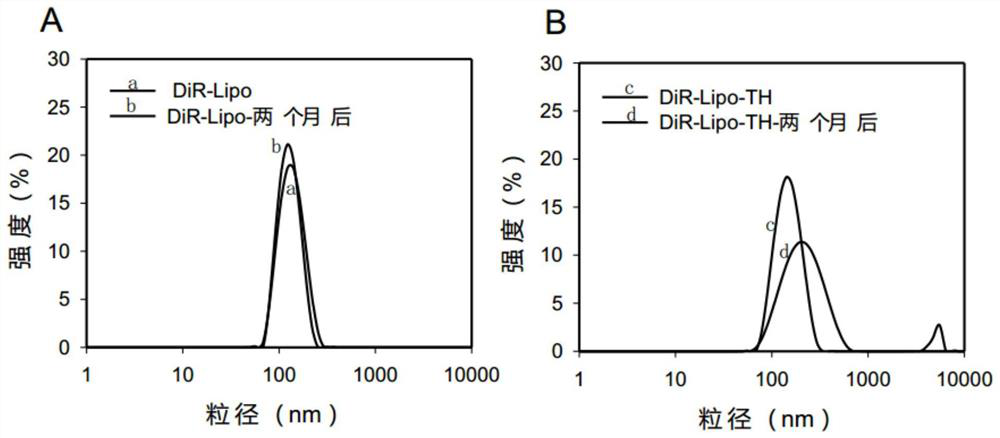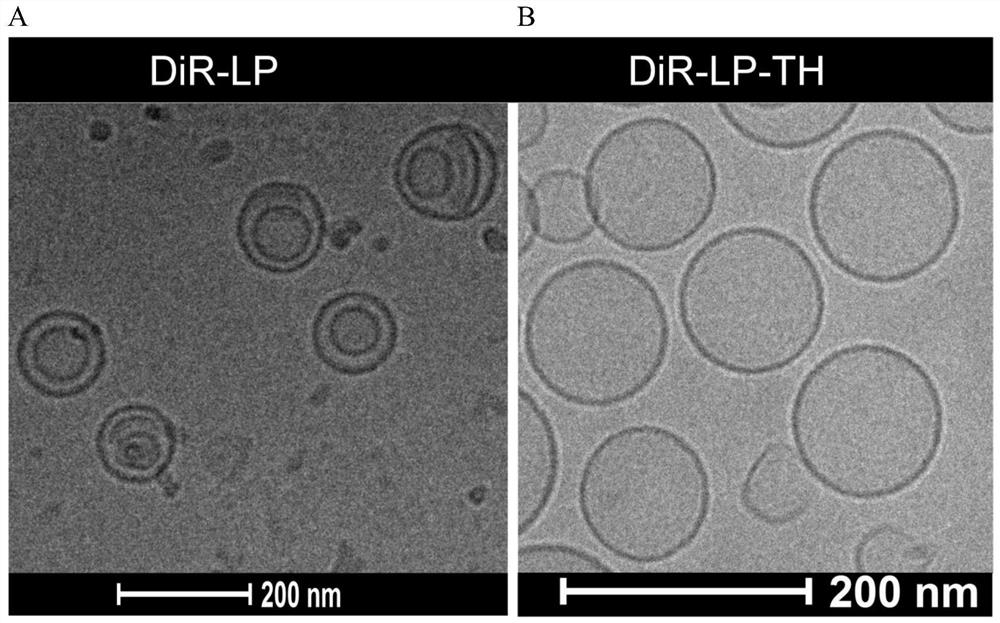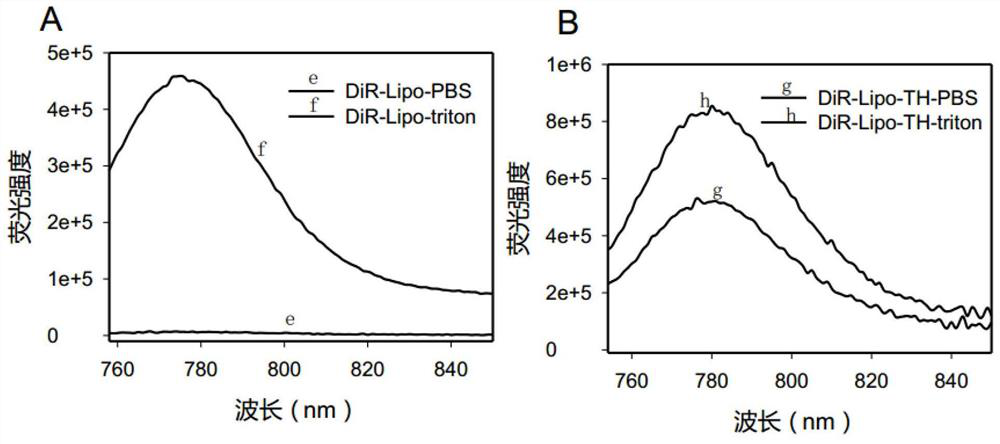A switch-type liposome nano fluorescent probe and its preparation method and application
A nano-fluorescent probe, liposome technology, applied in the field of nanotechnology and fluorescence diagnosis research, can solve the problem of limited switching performance of dye intermolecular distance, etc., and achieve the effects of improving blood stability, improving ACQ efficiency, and reducing interference
- Summary
- Abstract
- Description
- Claims
- Application Information
AI Technical Summary
Problems solved by technology
Method used
Image
Examples
Embodiment 1
[0040] The preparation method of DiR-Lipo described in this embodiment is as follows:
[0041] Distearoylphosphatidylcholine (DSPC), cholesterol, distearoylphosphatidylethanolamine-polyethylene glycol (DSPE-PEG2000) in a molar ratio of 55:40:5 (total lipid molar concentration 5mM) Dissolve in chloroform, then remove the chloroform by rotary evaporation to form a lipid film;
[0042] Add 350 mM ammonium sulfate aqueous solution into the lipid film, and rotate in a 60° C. water bath to hydrate the lipid film. After the lipid film to be formed is hydrated to become an emulsion liposome suspension, extrude 10 times on a 100nm polycarbonate film with an extruder;
[0043] The extruded liposome solution was dialyzed 3 times with 100 mM acetate buffer to form a liposome preparation with ammonium sulfate gradient (inside: 350 mM ammonium sulfate; outside: 100 mM acetate buffer)
[0044]Mix the liposome solution obtained in the previous step with the DMSO solution of DiR (DiR account...
Embodiment 2D
[0049] Morphology comparison of embodiment 2DiR-Lipo and DiR-Lipo-TH
[0050] The DiR-Lipo prepared in Example 1 is indeed encapsulated in the aqueous core of liposomes, and the morphology of DiR-Lipo and DiR-Lipo-TH is characterized by cryo-transmission electron microscopy (Cryo-TEM). The results are shown in figure 2 . Such as figure 2 As shown in A, the DiR-Lipo core exhibits a bilayer conformation with an electron-dense structure, indicating that the ammonium ion forms a complex with DiR and is retained in the aqueous core of the liposome. However, the detection result of DiR-Lipo-TH (2B) did not show a bilayer structure, indicating that DiR entered the hydrophobic phase.
Embodiment 3D
[0051] Example 3 Fluorescence comparison of DiR-Lipo and DiR-Lipo-TH before and after membrane rupture
[0052] The DiR-Lipo prepared in Example 1 is indeed encapsulated in the aqueous core of liposomes, and has in vitro fluorescence activatable properties. This example will use 0.05% Triton X-100 to treat DiR-Lipo and DiR-Lipo -TH perform membrane rupture respectively. First dilute DiR-Lipo and DiR-Lipo-TH with PBS to measure the fluorescence intensity of liposomes in the intact state, then add 0.05% Triton X-100 to disrupt the membrane of liposomes, and measure the dye DiR in monomeric state Fluorescence intensity, compare the fluorescence intensity before and after membrane rupture, the results are shown in image 3 . Depend on image 3 A shows that the fluorescence intensity of DiR-Lipo after membrane rupture (f) is much greater than the fluorescence intensity before membrane rupture (e), and the fluorescence enhancement factor is 70 times, indicating that the fluoresce...
PUM
 Login to View More
Login to View More Abstract
Description
Claims
Application Information
 Login to View More
Login to View More - R&D
- Intellectual Property
- Life Sciences
- Materials
- Tech Scout
- Unparalleled Data Quality
- Higher Quality Content
- 60% Fewer Hallucinations
Browse by: Latest US Patents, China's latest patents, Technical Efficacy Thesaurus, Application Domain, Technology Topic, Popular Technical Reports.
© 2025 PatSnap. All rights reserved.Legal|Privacy policy|Modern Slavery Act Transparency Statement|Sitemap|About US| Contact US: help@patsnap.com



